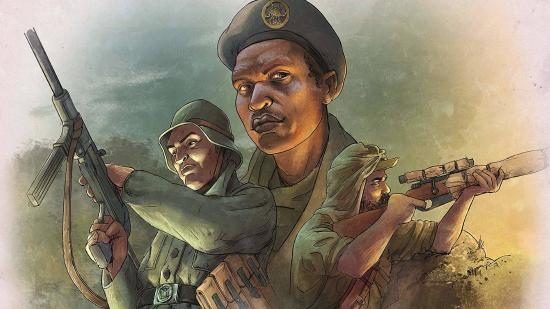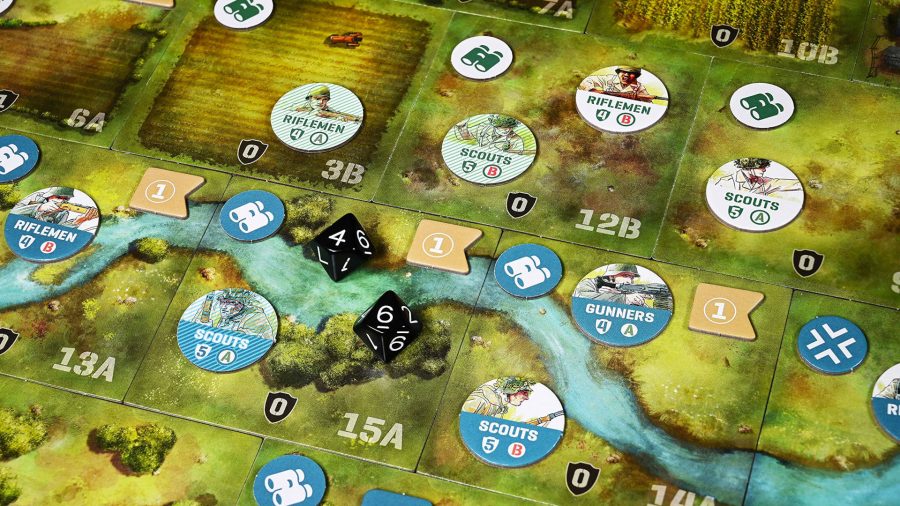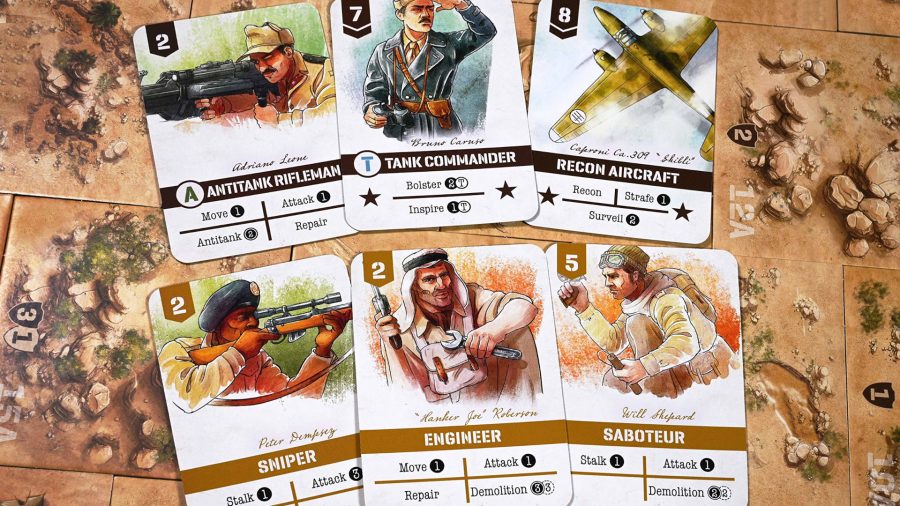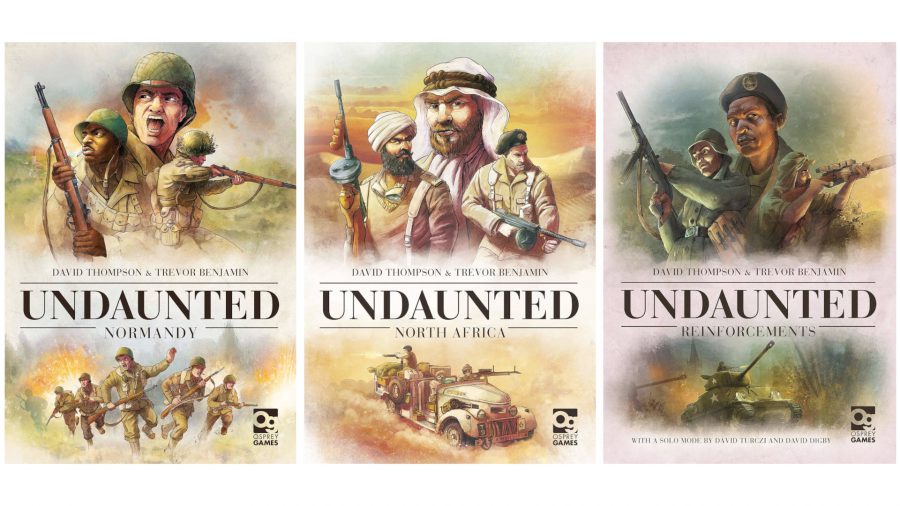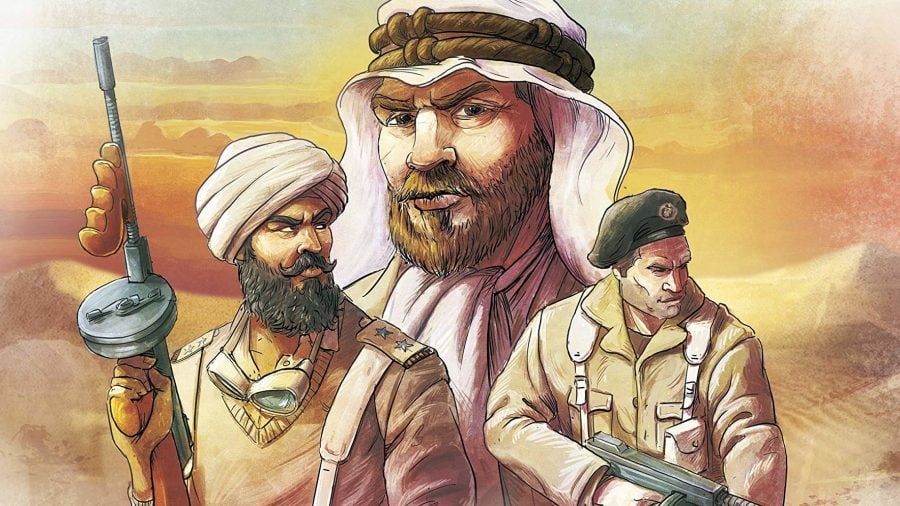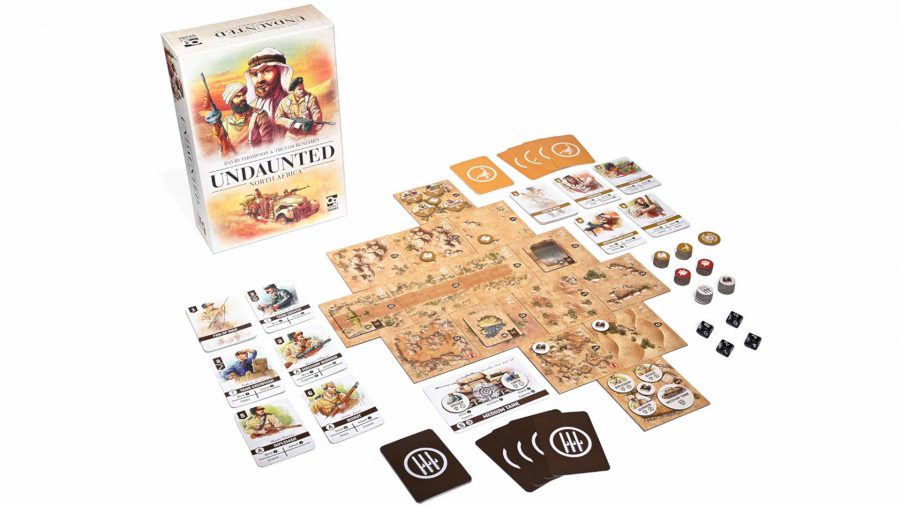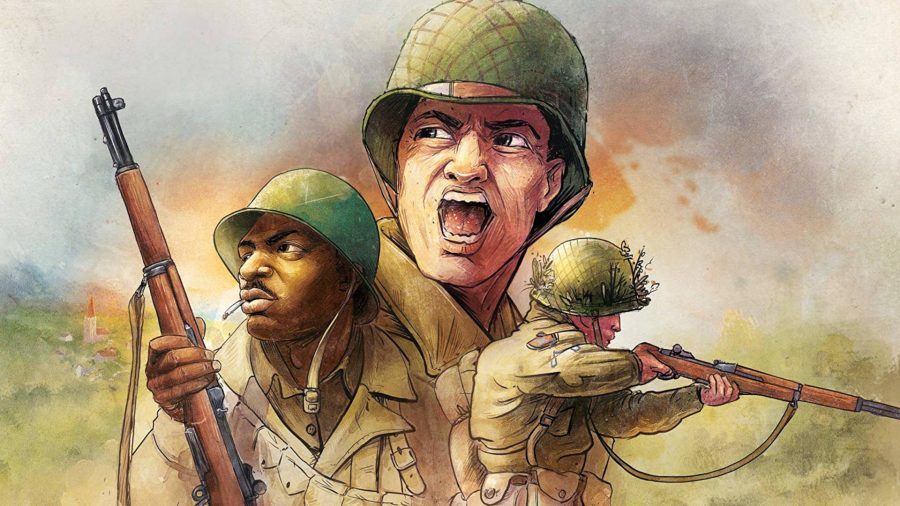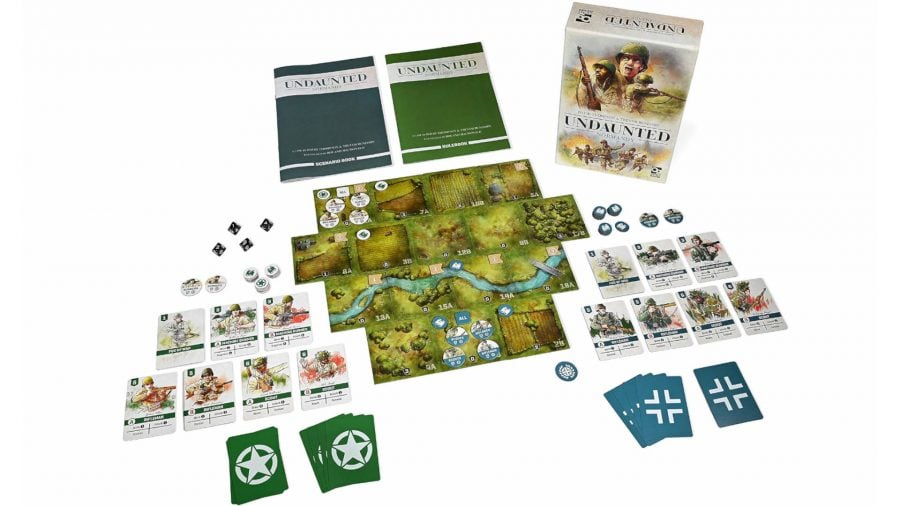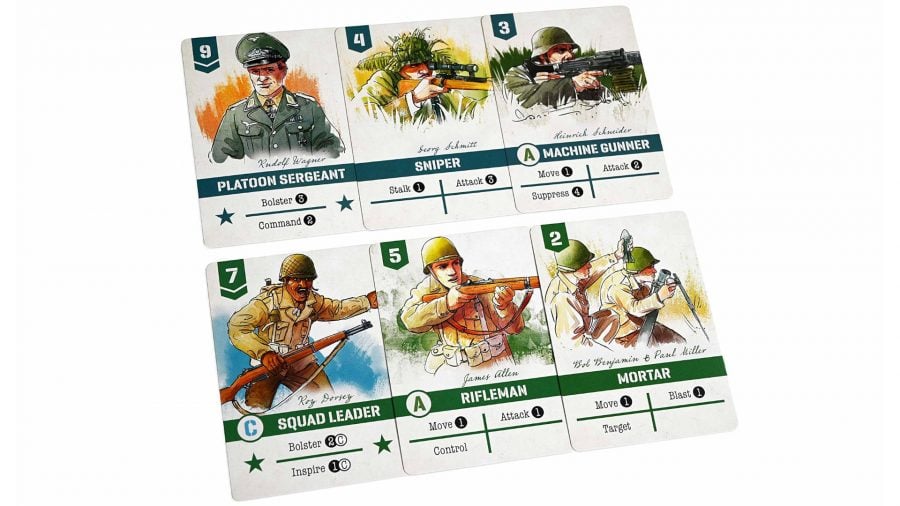Undaunted was something of a surprise hit when it appeared in 2019. Among the reams of WW2 games that release every year, a board game about leading a squad of US infantry through German lines wasn’t guaranteed to stand out. But Undaunted’s heady mix of deck-building, wargame tactics, and modular scenarios quickly carved out a space for itself in the tabletop community. We even chose the series’ first title, Undaunted: Normandy, as one of the best board games to play in 2021.
Two years after Normandy released, and over a year since follow-up Undaunted: North Africa hit shelves, a third instalment is on the way. Titled Undaunted: Reinforcements, it’s an expansion pack that will introduce various new units to the games, as well as two new game modes that extend the scenarios of Normandy and North Africa to different player counts.
We sat down with Undaunted series creators David Thompson and Trevor Benjamin ahead of the release of Reinforcements this November to talk through the expansion’s contents and design.
Wargamer: What are the topline features of Undaunted: Reinforcements?
Trevor Benjamin: The first thing it’s adding is two new modes. There’s a four-player team mode and a comprehensive solo mode. And then we’ve got eight new scenarios – there’s four for Normandy, four for North Africa – and a bunch of new content is integrated into that as well.
On the Normandy side, we’ve introduced tanks for both sides and some asymmetry in the rifleman. So the Germans get some submachine gunners, and the Americans get some grenade launchers. The cool thing is, those work in the new scenarios, but you can also go back and add those riflemen into all of the original Normandy scenarios. It adds a bit of asymmetry and additional tactical depth for each of those scenarios.
David Thompson: For the eight new scenarios we’re adding, you can play each of those two-player or four-player. But the solo play is a little bit out of control. It’s literally every single scenario from Normandy, every single scenario from North Africa, plus the eight new scenarios. And you can play each one as either side [US vs. Germans, or Italians vs. British]. So there’s 62 ways to play solo, and every one of those is tailored to the scenario.
How did you go about adding asymmetry to the original games, which were completely symmetrical?
DT: When we went back, we said ‘OK, people want asymmetry. What’s one of the most clichéd things that’s different about a German unit?’. Almost everybody knows that the Germans, especially late in the war, had some machine gunners in their platoons. And then we tried to find something that was relatively unique on the American side, so we landed on the grenade launcher. It needed to be a mechanical effect that was interesting and useful, but not overwhelming. We had to design it in such a way that was largely balanced in the old scenarios. Which was not easy.
One on one: These are the best 2-player board games
TB: We knew how the submachine gunners would work quite quickly, so it was really playing around with the grenades launchers to make them feel different, but to maintain that sense of balance. You always hear people say that you know you’ve balanced an asymmetrical game when both sides think the other side is massively better than them. So that’s what we’re aiming for.
How do four-player team games in Reinforcements work?
TB: You’re divided up into teams of two, but it’s largely the same. The scenarios are specially designed, so there’s a two-player version of the scenario and a four-player version. The structure of the board and the starting locations of all of the units are the same, but you essentially split up the troops across the two players.
So one player might get Squad A and the tanks, and the second player will get Squad B, and the sniper and mortar, or whatever. You have your own starting deck, and you have your own supplies, but the only cards you share are the Fog of War cards. So you’re working together to meet the objectives of that scenario, but you have essentially split forces.
In terms of the round structure, you take turns with the Platoon Sergeant card, and at the start of each round, it’s the two players on each side who have that card that bid for initiative. Based on who wins initiative, that determines the order of all of the four players. So if I win initiative, I go first, then the player with the Platoon Sergeant on the other side, then my partner, and then the fourth player. But as soon as you play the Platoon Sergeant card, it goes into your partner’s discard, and they take on that role. Everything else for the game is the same.
DT: I think Guide is the only action that you can take to help your partner’s units. Otherwise, you can’t control their units.
How important was historical authenticity in your design of Reinforcements?
DT: In the spectrum of games that I’ve designed that could be categorised as wargames, it is by far the one I’m least concerned about when it comes to historicity. Orders of magnitude less concerned. The audience that would be our target demographic could be wargamers or not, but really it’s the person who kind of likes wargames, but wants to play games with their family and friends.
So every scenario is inspired by a real scenario, but we are not trying to recreate that scenario accurately. And similarly, if you know about the structure of a platoon, and you’re playing the game like ‘Wow, there’s the correct number of riflemen in the squad’, you should be able to see those things. But you certainly shouldn’t need to know those things to play it. We will always err on the side of making it a good game before anything else.
Talk me through the new units in Reinforcements and how they’ll shake up the game?
TB: On the Normandy side, we’ve added the submachine gun and grenadier. With submachine gunners, when they’re in the same space as the unit they’re attacking, they get to roll two dice to represent the submachine gun working well at close range. Then on the American side, you can use the grenade launcher to attack up to two spaces away, but it attacks all enemy units in that space. Both of those add some extra tactical options by making movement and positioning more important.
The other big thing, of course, in Normandy is we’ve added tanks on both sides. This was interesting because there’s obviously a tank in the North Africa base game, but they work quite differently here because of the scale.
Sequel incoming: The next Undaunted sequel is in the works
So on the Reinforcements Normandy side, each tank is a single unit on the board, and each card is one of the crewmen. It’s abstract, but essentially each of the cards can perform all of the actions of the tank. We haven’t specialised the crewmen cards.
A big thing in terms of the design was making sure they added to the game, but they didn’t take over the roles of any of the existing stuff. We experimented with allowing them to control things, but if they can do that, it makes the rifleman less relevant. And they have a decent suppress, but it’s not as good as the Machine Gunner suppress action. So we had to make sure that all of the other units still have their place.
What about the new units for North Africa?
DT: One thing we’ve introduced for North Africa is mines, and the ability to create chokepoints. They play significantly in the design of the new scenarios. That is probably the biggest new addition, especially for the LRDG [British Army]. You can place and remove mines, which only damage your opponent. So it gives you the flexibility to do some really interesting interactions with the board that didn’t exist in the game before. You couldn’t really interact with the board state.
What inspired the new units for the Italians is essentially – this is an oversimplification – but their version of the LRDG. So now the Italians have these guys that have unique combinations of actions. None of them are earth-shatteringly new, but it does provide the Italian player with some new toys to play with in different combinations. The Italians also have a new aircraft which has new abilities. One’s air support, where you can draw directly from the supply into hand. And we have a bomb ability, letting you target any space on the board and attack everything in the space.
What can you tell me about Undaunted’s new solo mode?
DT: One thing we should say, just to give credit where credit’s due, is that Dávid Turczi designed the original concept of the solo system, but I think the vast, vast majority of the work that was done, was done by David Digby. He basically did all of the scenario development, and Anthony Howgego, who is a developer at Osprey, did a ton of the development on it, too.
Trevor and I aren’t that familiar with this. My general stance on solo design is if I’m working on a solo game, I like it to be solo from the start. And if it’s a multiplayer game that we worked on, then I feel way more comfortable with somebody that has the skills of turning a multiplayer game into a solitaire game, which is a skill set I don’t have.
Cream of the crop: These are simply the best board games around
But generally speaking, it’s driven by a system where you take a set of cards that are specific to the units in the scenario – so if you’re playing scenario four in Undaunted: Normandy, you’re going to go find the AI for each individual unit for scenario four. In most scenarios, scouts are trying to do basically the same thing, so the scout AI card might be the same for scenarios four through nine, for example.
But once you have those out, it’s relatively straightforward: if the AI plays a scout, do this thing. If you can’t do /this/ thing, do /that/ thing. If you’ve ever seen a Dávid Turczi decision tree design, it’s very familiar.
What excites you most about Undaunted: Reinforcements?
DT: Team play, for sure. My favourite part in any game, ever, is team play. Like Birth of America: 1775, or Quartermaster General – any sort of light wargame that supports team play – that’s my jam.
TB: I really like the team play too, and I’m a big fan of the mines. I like that element of interacting with the board directly. I also really like the specialists – the submachine gun – and the fact you can go back and play through all the Normandy scenarios with that little wrinkle. It does add quite a bit of tactical depth to the game, extra depth to the game, with relatively little rules complexity. I don’t know if I would go so far as to say we should have put it in the base game, probably not. I’m a huge fan of simplicity in rule sets and trying to get as much out of as little as possible. And I feel that those hit that really well.
Why do you think the Undaunted series has become so popular?
DT: We never expected it to be as successful as this, so we’re obviously super happy about that. But going in, it kind of could have gone one of two ways: it was either going to be a game that had broad appeal or a game that appealed to nobody – if no wargamers wanted to play because it’s not a war game, and no eurogames would want to play a game about World War Two. So we’re lucky with the way it went.
I think if you know what’s happened in Wargaming in the last 15 to 20 years – with the transition to card-driven games and COIN games that have euro inspirations – that sort of paved the way for a wargaming community that would be accepting of a light crossover game like this. And just from the general trend of games, it’s very difficult to categorise many games at this point as a eurogame, or an ameritrash game, or wargame. The hybridization of games has absolutely helped us. It straddles all the camps; the communities on both sides are primed for this kind of game already.
Tactical mind: Our pick of the best strategy board games
TB: It’s certainly not the first game which has been a light, approachable wargame. It often – I can’t believe that it does – but it often gets compared to Memoir 44, which was clearly designed to be an approachable World War Two game. But from the perspective of wargames, it’s very, very light in terms of rules complexity, and approachable in that way. I think that’s a big part of it. And I think that the fact that it has this deck-building mechanic. Non-wargamer gamers know deck-building. It’s a familiar mechanic, they know what it is, they’ve played lots of them before. So that’s pulled a lot of people in and has allowed people to play a wargame with people that they wouldn’t normally have been able to.
DT: One thing that also helped us, I think, is that Duncan Malloy [who signed the game to Osprey Games] actually commissioned Undaunted: North Africa before Normandy was ever even released. So Trevor and I have worked on Undaunted games two years out. We were done with the design for North Africa before Undaunted: Normandy released. Having that prepped and ready to within a year of Normandy being well received and released, I think that helped, too.
Do you see the Reinforcements as the definitive way of playing the series?
TB: I think it does the right job of adding that extra bit for people who are familiar with it. And it brings in a new community of people who specifically wanted a solo experience. So it’s the definitive solo mode. From the beginning, there’s been lots of community, homegrown solo versions, but I guarantee you that none of the ones out there have put as much effort into what Digby and Turczi and Anthony put into this.
DT: This is a super minor, personal thing, but in my mind’s eye when I’m playing North Africa, it’s almost like the cinematic experience of a commando raid. Now we’ve provided the Italian players with a little bit more of that experience that they might not have had before. So I do think that on the Italian side, with the four new scenarios, there’ll be a lot of excitement about that.
